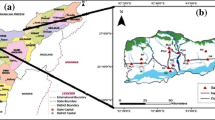Abstract
The study was carried out with an aim to assess the heavy metal (HM) and polycyclic aromatic hydrocarbons (PAHs) in the air of a biodiversity as well as tourist-rich area of Western Ghats by applying a most frequent growing lichen Remototrachyna awasthii (Hale and Patw.) Divakar and A. Crespo, as biomonitor. Thalli of R. awasthii were collected from eight sites of Mahabaleshwar area located in Western Ghats. Samples were prepared for HM and PAHs quantification by ICP-MS and HPLC, respectively. Total metal concentration (HM) ranged from 644 to 2,277.5 μg g−1 while PAHs concentration between 0.193 and 54.78 μg g−1. HM and PAHs concentrations were the highest at Bus Stand while control site (Lingmala Fall) exhibited the lowest concentration of HM as well as PAHs followed by samples from Wilson point (both these sites are having trekking route). It was also evident from this study that vehicular emission played a significant role in the release of HM and PAHs as pollutants in the environment. The effectiveness of R. awasthii as biomonitor could be further investigated by comparing this species with other biomonitors.



Similar content being viewed by others
References
Bajpai R, Upreti DK, Dwivedi SK (2009) Arsenic accumulation in lichens of Mandav monuments, Dhar district, Madhya Pradesh, India. Environ Monit Assess 159:437–442. doi:10.1007/s10661-008-0641-7
Bajpai R, Upreti DK, Dwivedi SK (2010) Passive monitoring of atmospheric heavy metals in a historical city of central India by Lepraria lobificans Nyl. Environ Monit Assess 166:477–484. doi:10.1007/s10661-009-1016-4
Caricchia A, Chiavarini S, Pezza M (1999) Polycyclic aromatic hydrocarbons in the urban atmospheric particulate matter in the city of Naples (Italy). Atmos Environ 33:3731–3738. doi:10.1016/S1352-2310(99)00199-5
Cheng J, Yuan T, Wu Q, Zhao W, Xie H, Ma Y, Ma J, Wang J (2007) PM10-bound polycyclic aromatic hydrocarbons (PAHs) and cancer risk estimation in the atmosphere surrounding an industrial area of Shanghai, China. Water Air Soil Pollut 183(1–4):437–446. doi:1007/s11270-007-9392-2
Conti ME, Cecchetti G (2001) Biological monitoring: lichens as bioindicator of air pollution assessment—a review. Environ Pollut 114:471–492
CPCB (2005) Parivesh: proposed limits for Pah in India. Central pollution Control Board, Ministry of Environment and Forest, Delhi–32. (http://www.cpcb.nic.in)
Divakar PK, Lumbsch HT, Ferencova Z, Prado RD, Crespo A (2010) Remototrachyna, a newly recognized tropical lineage of lichens in the Hypotrachyna clade (Parmeliaceae, Ascomata), originated in the Indian subcontinent. Am J Bot 7(4):579–590
Frati L, Brunialti G, Loppi S (2005) Problem related to lichen transplants to monitor trace element deposition in repeated survey: a case study from central Italy. J Atmos Chem 52:221–230
Garćia AZ, Coyotzin CM, Amaro AR, Veneroni DL, Martínez CL, Iglesias GS (2009) Distribution and sources of bioaccumulative air pollutants at Mezquital Valley, Mexico, as reflected by the atmospheric plant Tillandsia recurvata L. Atmos Chem Phys 9:6479–6494
Halek F, Kianpour-rad M, Kavousi A (2010) Characterization and source apportionment of polycyclic aromatic hydrocarbons in the ambient air (Tehran, Iran). Environ Chem Lett 8:39–44
Khalili NR, Scheff PA, Holsen TM (1995) PAH source fingerprints for coke oven, diesel, and gasoline engines highway tunnels and wood combustion emissions. Atmos Environ 29(4):533–542
Khillare PS, Agarwal T, Shridhar V (2008) Impact of CNG implementation on PAHs concentration in the ambient air of Delhi: a comparative assessment of pre- and post-CNG scenario. Environ Monit Assess 147:223–233
Lalnunmawia H (2010). Impact of tourism in India. www.itopc.org/travel-equisite/tourism-statistics.html. Assessed on 28 Nov 2011
Mastral AM, Lopez JM, Callen MS, Garcýa T, Murillo R (2003) Spatial and temporal PAH concentrations in Zaragoza, Spain. Sci Total Environ 307:111–124
Pandey PK, Patel KS, Lenicek J (1999) Polycyclic aromatic hydrocarbons: study of an urban-industrial location in India. Environ Monit Assess 59:287–319. doi:10.1023/A:1006169605672
Pinho P, Augusto S, Branquinho C, Bio A, Pereira MJ, Soares A, Catarino F (2004) Mapping lichen diversity as a first step for air quality assessment. J Atm Chem 49:377–389
Pirintsos SA, Matsi T, Vokou D, Gaggi C, Loppi S (2006) Vertical distribution patterns of trace elements in an urban environment as reflected by their accumulation in lichen transplant. J Atmos Chem 54:121–131
Ratola N, Amigo JM, Alves A (2010) Levels and Sources of PAHs in Selected Sites from Portugal: biomonitoring with Pinus pinea and Pinus pinaster Needles. Arch Environ Contam Toxicol 58:631–647. doi:10.1007/s00244-009-9462-0
Satya, Upreti DK, Patel DK (2011) Rinodina sophodes (Ach.) Massal., a bioaccumulators of polycyclic aromatic hydrocarbons (PAHs) in Kanpur City, India. Environ Monit Assess 184(1):229–238. doi:10.1007/s10661-011-1962-5
Shukla V, Upreti DK (2009) Polycyclic aromatic hydrocarbon (PAH) accumulation in lichen, Phaeophyscia hispidula of DehraDun city, Garhwal Himalayas. Environ Monit Assess 149(1–4):1–7
Shukla V, Upreti DK, Patel DK, Tripathi R (2010) Accumulation of polycyclic aromatic hydrocarbons in some lichens of Garhwal Himalayas, India. Int J Environ Waste Manag 5(1–2):104–113. doi:10.1504/IJEWM.2010.029695
Shukla V, Patel DK, Upreti DK, Yunus M (2012a) Lichens to distinguish urban from industrial PAHs. Environ Chem Lett 10:159–164. doi:10.1007/s10311-011-0336-0
Shukla V, Patel DK, Upreti DK, Yunus M, Prasad S (2012b) A comparison of heavy metals in lichen (Pyxine subcinerea), mango bark and soil. Int J Environ Sci Technol. doi:10.1007/s13762-012-0075-1
US-EPA (1986). Test methods for evaluating solid waste, vol 1B. Laboratory manual physical/chemical methods. Washington DC
Yang H, Hsieh L, Liu H, Mi H (2005) Polycyclic aromatic hydrocarbon emissions from motorcycles. Atmos Environ 39:17–25. doi:10.1016/j.atmosenv.2004.09.054
Yassaa N, Meklati BY, Cecinato A, Marino F (2001) Particulate n-alkanes, n-alkanoic acids and polycyclic aromatic hydrocarbons in the atmosphere of Algiers City area. Atmos Environ 35:1843–1851
Zhang X, Tao S, Liu W, Yang Y, Zuo Q, Liu S (2005) Source diagnostics of polycyclic aromatic hydrocarbons based on species ratio. Environ Sci Technol 39:9109–9114. doi:10.1021/es0513741
Acknowledgments
The authors are thankful to the Director, CSIR-National Botanical Research Institute, Lucknow for providing laboratory facilities. One of the authors (RB) is grateful to Department of Science and Technology (DST-SERC), New Delhi (SR/FTP/ES-134/2010) for award of Young Scientist fellowship.
Author information
Authors and Affiliations
Corresponding author
Rights and permissions
About this article
Cite this article
Bajpai, R., Shukla, V. & Upreti, D.K. Impact assessment of anthropogenic activities on air quality, using lichen Remototrachyna awasthii as biomonitor. Int. J. Environ. Sci. Technol. 10, 1287–1294 (2013). https://doi.org/10.1007/s13762-012-0156-1
Received:
Revised:
Accepted:
Published:
Issue Date:
DOI: https://doi.org/10.1007/s13762-012-0156-1




